 Dance, by A. C. Lucchesi.
Dance, by A. C. Lucchesi.
Should we make a distinction between allegorical statues representing Dance, and simple statues of Dancers? Perhaps, but we shall not. Allegorical figures of Dance are generally female, typically lithe and youthful, but not always. We may have a couple dancing, with a harmonious grouping and repetition of lines of their limbs – indeed, harmony is a feature of Dance. Dance is usually in motion, dancing – but not always, as we can have a figure as if arrested in an instantaneous pause. Dance is typically nude, or at most lightly clad – any drapery gives a way to emphasise movement and speed with swirling folds. In general she will not carry anything in her hands, though there are exceptions. Dance is found in Victorian allegorical statues, but she is above all a feature of art of the turn of the century and beyond, being entirely appropriate to illustrate the ideals of art nouveau.
The twisting, turning muscular figure of Dance at the top of the page is the work of A. C. Lucchesi. The swaying figure below is by A. G. Walker, and is seen to advantage from the angle shown, with her wrist at the perfect angle.
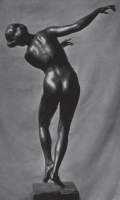 A. G. Walker's graceful dancing girl.
A. G. Walker's graceful dancing girl.
Here we have two dancing figures of a more solid, sculptural appearance, emphasising balanced mass and weight rather than line and silhouette. The figure by Derwent Wood, his diploma piece from 1921, wears light dancing shoes and but for that could have as easily been identified with some other allegory. Bertram Mackennal’s figure of 15 years earlier is rather similar in physique.

 Figures by Derwent Wood and Bertram Mackennal.
Figures by Derwent Wood and Bertram Mackennal.
The crouching figure with a hoop below is an earlyish work by Gilbert Bayes, The Greek Dancer, but epitomises a certain strand of art deco more than two decades later.
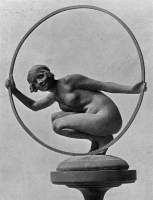 The Greek Dancer, by Gilbert Bayes.
The Greek Dancer, by Gilbert Bayes.
I hesitated to include the two pictures below, for fear of offending visitors with a more delicate constitution, but these chubby hideousities do illustrate a type of cherubic vision of Dance, in a bacchanalian sense. They are the work of Emil Fuchs, and are among a number of panels high up on the façade of the Waldorf Hotel in Aldwych.
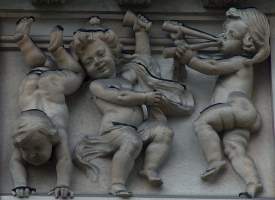
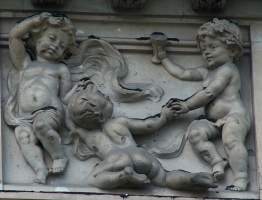 Emil Fuchs panels on the Waldorf Hotel.
Emil Fuchs panels on the Waldorf Hotel.
We conclude here with two modern sculptures. On the left is Enzo Piazotta’s Young Dancer opposite the Royal Opera House, Bow Street. A modern treatment, a sympathetic portrait of an almost gawky youthful figure, demonstrating that Dance need not absolutely be dancing. This work is a particularly welcome addition to the London streets. Finally, below right, Dancers is a less familiar example of David Wynne’s work (though the male head is characteristic of other of his works), standing in Cadogan Square. The emphasis here is very much on movement, with some nice lines formed by the arms and legs of the two figures echoing each other. The only regret is that the work is fenced off from the public within the square, presumably for the sole delectation of the local residents.
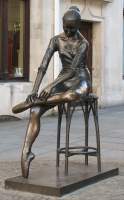
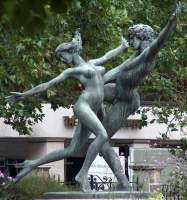 Modern pieces by Enzo Piazotti and David Wynne.
Modern pieces by Enzo Piazotti and David Wynne.
Back to Allegorical sculpture - C // Onward to Allegorical sculpture - E // Full Alphabet of Allegorical sculpture
Sculpture in London // Sculpture in England // Sculptors
Visits to this page from 13 Mar 2014: 7,144